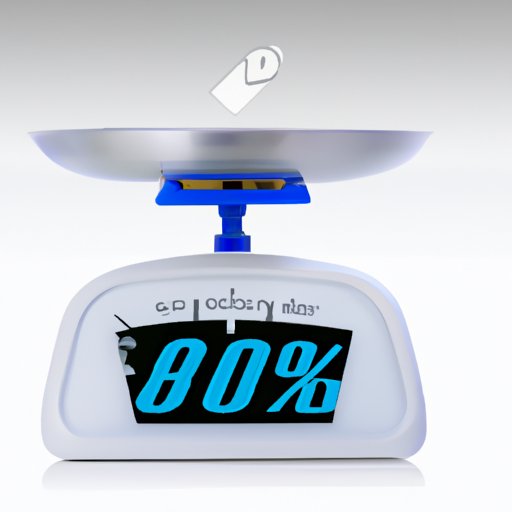
Introduction
Calculating weight percentages is an essential skill in chemistry, the industrial sector, and the pharmaceutical industry. Weight percent is the ratio of the mass of a particular component to the total mass of the system. In this article, we will discuss the importance of weight percent calculations and provide practical guidance on how to calculate weight percent using basic equations and digital scales. We will also cover the importance of accurately calculating weight percent in industrial settings, precise formulations, and the pharmaceutical industry.
A Beginner’s Guide to Calculating Weight Percentages in Chemistry
In chemistry, weight percent is the ratio of the mass of a particular component to the total mass of the system. It’s an essential tool for measuring substances’ purity or determining solutions’ concentrations. For instance, when preparing a solution of hydrochloric acid, weight percent can help determine the exact amount of solute to use. The equation for calculating weight percent is:
Weight Percent = (Mass of Component ÷ Total Mass of Solution) x 100%
To calculate weight percent, you need to know the mass of the component and the total mass of the solution. Let’s say you have a solution that contains 500g of water and 50g of salt:
Weight Percent of Salt = (50g ÷ 500g) x 100% = 10%
Therefore, the weight percent of salt in the solution is 10%.
The Importance of Accurately Calculating Weight Percentages in Industrial Applications
In industrial applications, weight percent is essential in determining the quality and safety of various products. For example, in the food industry, weight percent is used to ensure that foods are prepared to the right standard and free of contaminants. In the textile industry, weight percent is used to ensure that the fabric’s dye adheres to the fibers correctly. Inaccurate weight percent calculations can lead to costly errors, resulting in the production of substandard goods that may harm human health and the environment.
How to Calculate Weight Percentages: Step-by-Step Guide
To calculate weight percent using a digital scale, follow these steps:
- Weigh the component using a digital scale.
- Weigh the container the component is in, and subtract the container’s weight from the component’s weight.
- Weigh the other components and repeat the process until you have the mass of all components that make up the solution.
- Calculate the total mass of the solution by adding the mass of all the components together.
- Calculate the weight percent of the component using the equation above.
If you’re calculating by hand, you’ll need to use a similar process but have fewer digits of precision, and it’s generally more time-consuming. Make sure that you weigh each component accurately to ensure your calculations are correct.
Master the Art of Calculating Weight Percentages for Precise Formulations
In precision formulations, it’s essential to have accurate weight percentages to achieve the desired result. For example, when preparing a drug, a formulation with an inaccurate weight percent can lead to undesired outcomes like incorrect dosing or reduced efficacy. To achieve precise weight percentages, it’s essential to use accurate digital scales and measure each component’s weight carefully. Always follow the instructions for use and ensure that you consider any factors that may impact the accuracy of your calculations.
Why Knowing How to Calculate Weight Percentages is Essential in the Pharmaceutical Industry
In the pharmaceutical industry, weight percentages are crucial in the development and manufacture of drugs. Weight percent is frequently used to determine the mass of active ingredients in a drug formulation, ensuring that the drug is effective and safe when prescribed. Inaccuracies in weight percent calculations can lead to undesired side-effects and may even be life-threatening in some cases. Precision calculations are, therefore, crucial in the pharmaceutical industry, with accurate digital scales being most commonly used to obtain these results.
The Benefits of Using a Digital Scale for Accurate Weight Percentage Calculations
Digital scales offer several benefits over other weight measurement techniques. They provide improved accuracy, allowing for more precise weight percentages, and are user-friendly, making them ideal for beginners. They’re also versatile, and you can use them to measure the weight of various substances, including liquids, solids, and gases, making them perfect for industrial settings where a variety of materials are used. These scales can help eliminate human error and improve the quality of products produced in the long run.
How to Interpret and Apply Weight Percentage Calculations to Real-World Problems
There are several real-world problems where weight percentage calculations are necessary, such as in analytical chemistry or industrial settings. For example, in the manufacture of pharmaceuticals, weight percent is used to monitor the content uniformity during production. Weight percent is also used in defining the dosing regimen of medications like chemotherapy drugs and antibiotics. By understanding how to calculate weight percentages, you can make informed decisions about products and processes that have a direct impact on people’s health and wellbeing.
Conclusion
Calculating weight percentages is crucial in several fields, from chemistry and industrial applications to the pharmaceutical industry. Accurate weight percent calculations can ensure the safety and effectiveness of products produced, while inaccurate calculations can lead to undesired outcomes. In this article, we’ve discussed the importance of weight percent calculations and offered a beginner’s guide to calculating weight percent, how to calculate weight percent step-by-step, and using digital scales to improve accuracy. Remember, accuracy is key in weight percent calculations, so ensure you use equipment and follow any relevant protocols, and quality control measures to ensure precise calculations are obtained.





